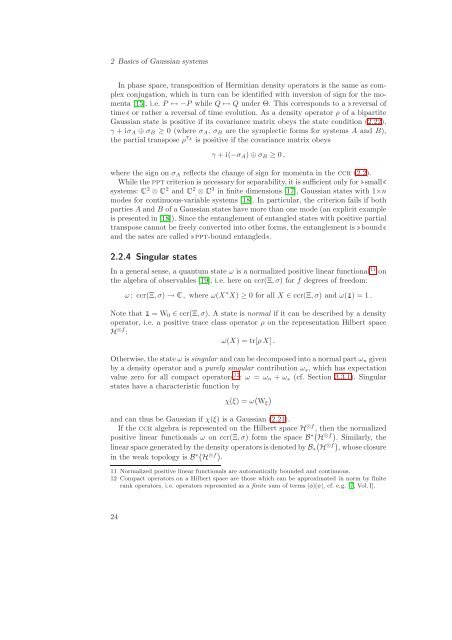Quantum Information Theory with Gaussian Systems
Quantum Information Theory with Gaussian Systems
Quantum Information Theory with Gaussian Systems
You also want an ePaper? Increase the reach of your titles
YUMPU automatically turns print PDFs into web optimized ePapers that Google loves.
2 Basics of <strong>Gaussian</strong> systems<br />
In phase space, transposition of Hermitian density operators is the same as complex<br />
conjugation, which in turn can be identified <strong>with</strong> inversion of sign for the momenta<br />
[15], i.e. P ↦→ −P while Q ↦→ Q under Θ. This corresponds to areversal of<br />
timeor rather a reversal of time evolution. As a density operator ρ of a bipartite<br />
<strong>Gaussian</strong> state is positive if its covariance matrix obeys the state condition (2.22),<br />
γ + iσA ⊕ σB ≥ 0 (where σA, σB are the symplectic forms for systems A and B),<br />
the partial transpose ρ T A is positive if the covariance matrix obeys<br />
γ + i(−σA) ⊕ σB ≥ 0 ,<br />
where the sign on σA reflects the change of sign for momenta in the ccr (2.2).<br />
While the ppt criterion is necessary for separability, it is sufficient only forsmall<br />
systems:2 ⊗2 and2 ⊗3 in finite dimensions [17], <strong>Gaussian</strong> states <strong>with</strong> 1×n<br />
modes for continuous-variable systems [18]. In particular, the criterion fails if both<br />
parties A and B of a <strong>Gaussian</strong> states have more than one mode (an explicit example<br />
is presented in [18]). Since the entanglement of entangled states <strong>with</strong> positive partial<br />
transpose cannot be freely converted into other forms, the entanglement isbound<br />
and the sates are calledppt-bound entangled.<br />
2.2.4 Singular states<br />
In a general sense, a quantum state ω is a normalized positive linear functional 11 on<br />
the algebra of observables [19], i.e. here on ccr(Ξ, σ) for f degrees of freedom:<br />
ω: ccr(Ξ, σ) →, where ω(X ∗ X) ≥ 0 for all X ∈ ccr(Ξ, σ) and ω( ) = 1 .<br />
Note that = W0 ∈ ccr(Ξ, σ). A state is normal if it can be described by a density<br />
operator, i.e. a positive trace class operator ρ on the representation Hilbert space<br />
H ⊗f :<br />
ω(X) = tr[ρ X] .<br />
Otherwise, the state ω is singular and can be decomposed into a normal part ωn given<br />
by a density operator and a purely singular contribution ωs, which has expectation<br />
value zero for all compact operators12 : ω = ωn + ωs (cf. Section 3.3.1). Singular<br />
states have a characteristic function by<br />
χ(ξ) = ω <br />
Wξ<br />
and can thus be <strong>Gaussian</strong> if χ(ξ) is a <strong>Gaussian</strong> (2.21).<br />
If the ccr algebra is represented on the Hilbert space H⊗f , then the normalized<br />
positive linear functionals ω on ccr(Ξ, σ) form the space B∗H⊗f <br />
. Similarly, the<br />
⊗f linear space generated by the density operators is denoted by B∗ H , whose closure<br />
in the weak topology is B∗H⊗f .<br />
11 Normalized positive linear functionals are automatically bounded and continuous.<br />
12 Compact operators on a Hilbert space are those which can be approximated in norm by finite<br />
rank operators, i.e. operators represented as a finite sum of terms |φ〉〈ψ|, cf. e.g. [7, Vol.I].<br />
24
















